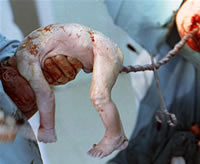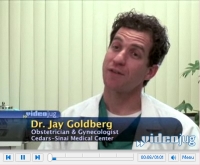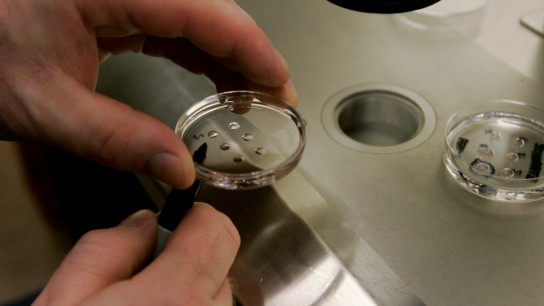Labor Stages: Pushing Baby Out
 Once your cervix has reached the point where it is fully dilated at 10cm then we start with the next stage of labor: pushing. At the start of this stage your contractions may become less frequent, so use this time to rest up and get back as much energy as you can.
The sensation to push depends on how your baby is sitting. Those whose baby’s are sitting lower tend to have the involuntary feeling of wanting to push as opposed to those whose baby’s are sitting higher up. If your baby is still sitting high up you needn’t worry, as the contractions through your uterus will begin to move your baby down. In many hospitals it’s still routine practice to encourage women to push only with each contraction, as this will help speed up the baby’s decent.
With each contraction the combination of the force of your uterus and your stomach muscles will place pressure on your baby to move down towards and through the birth canal. When a contraction ends your uterus will relax, which will mean that your baby will slip back a little.
As your baby moves down the birth canal you may notice that the perineum, (which is the area between your vagina and anus), begins to bulge out. This is an indication that your baby’s head is very close to popping out and pretty soon you will be able to just put your hand down and touch the top of your baby’s head. You may want to ask if you can use a mirror to see the top of baby’s head.
As baby’s head gets closer to exiting the birth canal the urgency to want to push increases dramatically especially as the head will become more and more visible with each contraction. As the head gets closer to coming out you may notice an increase in the pressure on your perineum and in many cases the skin in this area will even tear.
Your healthcare provider may ask you to either stop pushing, this is basically to try and give your baby’s head a chance to stretch and adjust to fit through birth canal.
As your baby’s head ‘crowns’ – the widest part becomes visible, you may start to feel the excitement rush through you. You are almost able to see baby’s face completely.
Once baby’s head has completely emerged from the birth canal your heathcare provider will suction his nose and mouth to clear out any blockages. He will also check your baby’s neck to ensure that the umbilical chord is not stuck around it. Should the umbilical chord be around his neck it is easy enough to slip it over or to clamp it and cut it straight away.
Your baby’s head will now turn to the side as the shoulders rotate into a position which allows them to slip through the birth canal and emerge on the outside. One more push and it should all be over! Congratulations!
Once baby is out of the birth canal he/she will be dried off as much as possible, mouth and nose will be suctioned again to ensure there are no obstructions and will be kept as warm as possible. Should everything have run smoothly and there not be any complications then he/she will be passed over to you and you will be able to meet your new baby for the very first time in person! Your caregiver will clamp the umbilical cord in two places and then cut between the two clamps or your partner can do the honors.
The entire second stage can last anywhere from a few minutes to several hours. Without an epidural, the average duration is close to an hour for a first-timer and 20 minutes if you’ve had a previous vaginal delivery. If you have an epidural, the second stage generally lasts longer.
Stage 3 : Afterbirth
Once your cervix has reached the point where it is fully dilated at 10cm then we start with the next stage of labor: pushing. At the start of this stage your contractions may become less frequent, so use this time to rest up and get back as much energy as you can.
The sensation to push depends on how your baby is sitting. Those whose baby’s are sitting lower tend to have the involuntary feeling of wanting to push as opposed to those whose baby’s are sitting higher up. If your baby is still sitting high up you needn’t worry, as the contractions through your uterus will begin to move your baby down. In many hospitals it’s still routine practice to encourage women to push only with each contraction, as this will help speed up the baby’s decent.
With each contraction the combination of the force of your uterus and your stomach muscles will place pressure on your baby to move down towards and through the birth canal. When a contraction ends your uterus will relax, which will mean that your baby will slip back a little.
As your baby moves down the birth canal you may notice that the perineum, (which is the area between your vagina and anus), begins to bulge out. This is an indication that your baby’s head is very close to popping out and pretty soon you will be able to just put your hand down and touch the top of your baby’s head. You may want to ask if you can use a mirror to see the top of baby’s head.
As baby’s head gets closer to exiting the birth canal the urgency to want to push increases dramatically especially as the head will become more and more visible with each contraction. As the head gets closer to coming out you may notice an increase in the pressure on your perineum and in many cases the skin in this area will even tear.
Your healthcare provider may ask you to either stop pushing, this is basically to try and give your baby’s head a chance to stretch and adjust to fit through birth canal.
As your baby’s head ‘crowns’ – the widest part becomes visible, you may start to feel the excitement rush through you. You are almost able to see baby’s face completely.
Once baby’s head has completely emerged from the birth canal your heathcare provider will suction his nose and mouth to clear out any blockages. He will also check your baby’s neck to ensure that the umbilical chord is not stuck around it. Should the umbilical chord be around his neck it is easy enough to slip it over or to clamp it and cut it straight away.
Your baby’s head will now turn to the side as the shoulders rotate into a position which allows them to slip through the birth canal and emerge on the outside. One more push and it should all be over! Congratulations!
Once baby is out of the birth canal he/she will be dried off as much as possible, mouth and nose will be suctioned again to ensure there are no obstructions and will be kept as warm as possible. Should everything have run smoothly and there not be any complications then he/she will be passed over to you and you will be able to meet your new baby for the very first time in person! Your caregiver will clamp the umbilical cord in two places and then cut between the two clamps or your partner can do the honors.
The entire second stage can last anywhere from a few minutes to several hours. Without an epidural, the average duration is close to an hour for a first-timer and 20 minutes if you’ve had a previous vaginal delivery. If you have an epidural, the second stage generally lasts longer.
Stage 3 : Afterbirth
 Related Video
In our pregnancy video section we have a whole range of videos for you to watch which cover a whole range of subjects, from general pregnancy, complications, newborn care and even beauty.
We have a video which related to labor – so be sure to check it out in the video section here
Related Video
In our pregnancy video section we have a whole range of videos for you to watch which cover a whole range of subjects, from general pregnancy, complications, newborn care and even beauty.
We have a video which related to labor – so be sure to check it out in the video section hereStages of Labor Part 2

